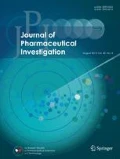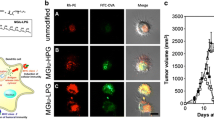Abstract
Vaccine adjuvants enhance immunogenic responses of antigens and increase potency of vaccines. Physicochemical properties of particulate vaccine adjuvants namely, particle size, surface charge, hydrophobicity, shape and composition play an important role to determine their activity and potency. Various studies have been done using different types of particulate vaccine adjuvants to correlate their physicochemical properties with immune responses. Generally, change in particle size does not show any trend in modulation of immunogenicity, however, it directly influences on cellular uptake of particles, leading to alteration of cytokine profile and induction of Th1 and/or Th2 responses. Usually, positively charged adjuvant particles undergo higher cellular uptake than negatively charged particles and hydrophobic particles undergo cellular uptake more efficiently than hydrophilic particles. Furthermore, shape and composition of adjuvant particles also influence on immune responses. This review gives an insight into the impact of particle size, surface charge, hydrophobicity, shape and composition of particulate vaccine adjuvants in modulating immune responses.


(redrawn and modified from Zhao et al. 2014)
Similar content being viewed by others
References
Agarwal R, Singh V, Jurney P, Shi L, Sreenivasan SV, Roy K (2013) Mammalian cells preferentially internalize hydrogel nanodiscs over nanorods and use shape-specific uptake mechanisms. Proc Natl Acad Sci 110:17247–17252
Akagi T, Baba M, Akashi M (2012) Biodegradable nanoparticles as vaccine adjuvants and delivery systems: regulation of immune responses by nanoparticle-based vaccine. In: Kunugi S, Yamaoka T (eds) Polymers in nanomedicine. Springer, Berlin, pp 31–64
Aucouturier J, Dupuis L, Ganne V (2001) Adjuvants designed for veterinary and human vaccines. Vaccine 19:2666–2672
Badiee A, Khamesipour A, Samiei A, Soroush D, Shargh VH, Kheiri MT, Barkhordari F, Mc Master WR, Mahboudi F, Jaafari MR (2012) The role of liposome size on the type of immune response induced in BALB/c mice against leishmaniasis: rgp63 as a model antigen. Exp Parasitol 132:403–409
Bastola R, Noh G, Keum T, Bashyal S, Seo JE, Choi J, Oh Y, Cho Y, Lee S (2017) Vaccine adjuvants: smart components to boost the immune system. Arch Pharmacal Res 40:1238–1248
Bovier PA (2008) Epaxal®: a virosomal vaccine to prevent hepatitis A infection. Expert Rev Vaccines 7:1141–1150
Burakova Y, Madera R, McVey S, Schlup JR, Shi J (2018) Adjuvants for animal vaccines. Viral Immunol 31:11–22
Chen X, Liu Y, Wang L, Liu Y, Zhang W, Fan B, Ma X, Yuan Q, Ma G, Su Z (2014) Enhanced humoral and cell-mediated immune responses generated by cationic polymer-coated PLA microspheres with adsorbed HBsAg. Mol Pharm 11:1772–1784
Chithrani BD, Ghazani AA, Chan WCW (2006) Determining the size and shape dependence of gold nanoparticle uptake into mammalian cells. Nano Lett 6:662–668
Foged C (2011) Subunit vaccines of the future: the need for safe, customized and optimized particulate delivery systems. Ther Deliv 2:1057–1077
Freitas E, Marinho AC, Albuquerque D, Teles L, Sindeaux M, Salles MT, Sousa DC, Lima MM, da Guia Silva M, Fernandes D (2013) Adjuvant activity of peanut, cottonseed and rice oils on cellular and humoral response. VacciMonitor 22:4–9
Giddam AK, Zaman M, Skwarczynski M, Toth I (2012) Liposome-based delivery system for vaccine candidates: constructing an effective formulation. Nanomedicine 7:1877–1893
Henriksen-Lacey M, Devitt A, Perrie Y (2011) The vesicle size of DDA: TDB liposomal adjuvants plays a role in the cell-mediated immune response but has no significant effect on antibody production. J Control Release 154:131–137
Iyer V, Cayatte C, Guzman B, Schneider-Ohrum K, Matuszak R, Snell A, Rajani GM, McCarthy MP, Muralidhara B (2015) Impact of formulation and particle size on stability and immunogenicity of oil-in-water emulsion adjuvants. Human Vaccines Immunother 11:1853–1864
Jansen T, Hofmans MPM, Theelen MJG, Manders F, Schijns VEJC (2006) Structure-and oil type-based efficacy of emulsion adjuvants. Vaccine 24:5400–5405
Jin SE, Hwang SJ (2017) Ocular delivery systems for the administration of antibody therapeutics. J Pharm Investig 47:373–382
Liu Y, Yin Y, Wang L, Zhang W, Chen X, Yang X, Xu J, Ma G (2013) Surface hydrophobicity of microparticles modulates adjuvanticity. J Mater Chem B 1:3888–3896
Mann JFS, Shakir E, Carter KC, Mullen AB, Alexander J, Ferro VA (2009) Lipid vesicle size of an oral influenza vaccine delivery vehicle influences the Th1/Th2 bias in the immune response and protection against infection. Vaccine 27:3643–3649
Marasini N, Skwarczynski M, Toth I (2017) Intranasal delivery of nanoparticle-based vaccines. Ther Deliv 8:151–167
Nakanishi T, Kunisawa J, Hayashi A, Tsutsumi Y, Kubo K, Nakagawa S, Nakanishi M, Tanaka K, Mayumi T (1999) Positively charged liposome functions as an efficient immunoadjuvant in inducing cell-mediated immune response to soluble proteins. J Control Release 61:233–240
Oyewumi MO, Kumar A, Cui Z (2010) Nano-microparticles as immune adjuvants: correlating particle sizes and the resultant immune responses. Expert Rev Vaccines 9:1095–1107
Park YM, Lee SJ, Kim YS, Lee MH, Cha GS, Jung ID, Kang TH, Han HD (2013) Nanoparticle-based vaccine delivery for cancer immunotherapy. Immune Netw 13:177–183
Schreiber HA, Prechl J, Jiang H, Zozulya A, Fabry Z, Denes F, Sandor M (2010) Using carbon magnetic nanoparticles to target, track, and manipulate dendritic cells. J Immunol Methods 356:47–59
Shah RR, O’Hagan DT, Amiji MM, Brito LA (2014) The impact of size on particulate vaccine adjuvants. Nanomedicine 9:2671–2681
Shah RR, Brito LA, O’Hagan DT, Amiji MM (2015a) Emulsions as vaccine adjuvants. In: Foged C, Rades T, Perrie Y, Hook S (eds) Subunit vaccine delivery. Springer, New York, pp 59–76
Shah RR, Dodd S, Schaefer M, Ugozzoli M, Singh M, Otten GR, Amiji MM, O’Hagan DT, Brito LA (2015b) The development of self-emulsifying oil-in-water emulsion adjuvant and an evaluation of the impact of droplet size on performance. J Pharm Sci 104:1352–1361
Sharma G, Valenta DT, Altman Y, Harvey S, Xie H, Mitragotri S, Smith JW (2010) Polymer particle shape independently influences binding and internalization by macrophages. J Control Release 147:408–412
Silva AL, Rosalia RA, Varypataki E, Sibuea S, Ossendorp F, Jiskoot W (2015) Poly-(lactic-co-glycolic-acid)-based particulate vaccines: particle uptake by dendritic cells is a key parameter for immune activation. Vaccine 33:847–854
Soema PC, Willems GJ, Jiskoot W, Amorij JP, Kersten GF (2015) Predicting the influence of liposomal lipid composition on liposome size, zeta potential and liposome-induced dendritic cell maturation using a design of experiments approach. Eur J Pharm Biopharm 94:427–435
Tabata Y, Inoue Y, Ikada Y (1996) Size effect on systemic and mucosal immune responses induced by oral administration of biodegradable microspheres. Vaccine 14:1677–1685
Thiele L, Merkle HP, Walter E (2003) Phagocytosis and phagosomal fate of surface-modified microparticles in dendritic cells and macrophages. Pharm Res 20:221–228
Thomas C, Rawat A, Hope-Weeks L, Ahsan F (2011) Aerosolized PLA and PLGA nanoparticles enhance humoral, mucosal and cytokine responses to hepatitis B vaccine. Mol Pharm 8:405–415
Vallhov H, Gabrielsson S, Strømme M, Scheynius A, Garcia-Bennett AE (2007) Mesoporous silica particles induce size dependent effects on human dendritic cells. Nano Lett 7:3576–3582
Wang T, Jiang H, Zhao Q, Wang S, Zou M, Cheng G (2012) Enhanced mucosal and systemic immune responses obtained by porous silica nanoparticles used as an oral vaccine adjuvant: effect of silica architecture on immunological properties. Int J Pharm 436:351–358
Wilkhu JS, McNeil SE, Anderson DE, Perrie Y (2013) Characterization and optimization of bilosomes for oral vaccine delivery. J Drug Target 21:291–299
Xiang SD, Scholzen A, Minigo G, David C, Apostolopoulos V, Mottram PL, Plebanski M (2006) Pathogen recognition and development of particulate vaccines: does size matter? Methods 40:1–9
Yoo JW, Doshi N, Mitragotri S (2010) Endocytosis and intracellular distribution of PLGA particles in endothelial cells: effect of particle geometry. Macromol Rapid Commun 31:142–148
Yotsumoto S, Aramaki Y, Kakiuchi T, Tsuchiya S (2004) Induction of antigen-dependent interleukin-12 production by negatively charged liposomes encapsulating antigens. Vaccine 22:3503–3509
Zaman M, Good MF, Toth I (2013) Nanovaccines and their mode of action. Methods 60:226–231
Zhao L, Seth A, Wibowo N, Zhao CX, Mitter N, Yu C, Middelberg APJ (2014) Nanoparticle vaccines. Vaccine 32:327–337
Acknowledgements
This research was supported by Technology Development Program (Project No. 316093-2 and Project No. 316094-2) for Bio-industry, Ministry for Agriculture, Food and Rural Affairs, Republic of Korea.
Author information
Authors and Affiliations
Corresponding author
Ethics declarations
Conflict of interest
All the authors declare that they have no conflicts of interest.
Research involving human participants and/or animals
This article does not contain any studies with human and animal subjects performed by any of the authors.
Rights and permissions
About this article
Cite this article
Bastola, R., Lee, S. Physicochemical properties of particulate vaccine adjuvants: their pivotal role in modulating immune responses. J. Pharm. Investig. 49, 279–285 (2019). https://doi.org/10.1007/s40005-018-0406-4
Received:
Accepted:
Published:
Issue Date:
DOI: https://doi.org/10.1007/s40005-018-0406-4




